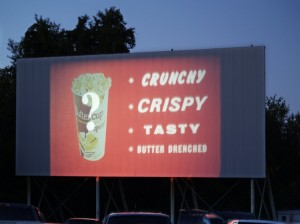Savvy marketers have known for decades about the power of social validation.

Photo credit: Ken Mayer
Any time you see or hear a line like “4 out of 5 doctors prefer…” or “10 million satisfied users can’t be wrong” you are being plied with social validation.
While going against the grain may be a good strategy for investing, when it comes to finding products and services to actually use, it often pays to follow the crowd.
When you pull into a restaurant parking lot and find that it’s empty, alarm bells should be going off. Either they are not serving yet, the food is terrible, the prices way too high or some other thing but if no one is eating there, you can be sure something is wrong.
With the explosion in smartphones, mobile communications and computer technology, crowdsourcing has taken off in a way that it never could before. Sites like Yelp enable users to post online reviews for all manner of products and/or services.
There are a bunch of terrific new apps coming out which take a slightly different twist on the concept. So let me list a few of my favorite crowd-enabled apps and websites.
1. Gas Buddy
This smartphone app, available for all smartphone platforms, will help you find the lowest gas prices within a 10 mile radius of your current location. Its millions of users are invited to report and update gas prices for any station they visit or pass. The app will tell you how recently prices for a given station were updated so you have some idea how accurate they are. You can also sort listings by distance or by price and even view stations on a map. This free app has saved me a bundle of money!
2. Waze
A GPS app that I’m absolutely in love with. It is available for iPhone, Android, Windows and Symbian. Beyond being merely a GPS with voice directions (by the way, the voice comes in your choice of both genders and over two dozen different languages!), Waze offers so much more. It alerts you when you are approaching traffic cameras, disabled vehicles, accidents, police speed traps, construction zones and so much more. It will even try to route you around these things whenever possible. Every Waze user is invited to submit reports of things that may affect driving conditions. Those reports are then sent to other nearby drivers who can corroborate or refute them.
You don’t even have to use Waze as a GPS. Simply turn it on when driving on familiar roads and leave it running in the background. It will not give you turn-by-turn directions (you don’t need them on familiar roads) but it will still warn you about road hazards ahead. This app saves me so much time and aggravation.
3. Indiegogo
This is really a website rather than an app. Its purpose is to enable small charitable fund drives, though there is no screening as for what constitutes a charitable cause. Users can request funds for anything they want from starting up a band to running a homeless shelter. You simply say how much money you want and what you intend to do with it. Others can decide for themselves whether or not they care to donate and how much to give. Users could give anything from a few cents to many thousands of dollars. It’s a great way to collect donations.
4. Quirky
A website that facilitates crowd-enabled inventing. Someone comes up with an idea for a new product and others can vote for it, thus endorsing it as a good idea, or even contribute refinements and improvements. Once an invention has been sufficiently refined and is deemed popular enough to be a likely commercial success, funders will help the inventor(s) bring it to market. Many extremely clever inventions that were developed in the Quirky community are also offered for sale on Quirky’s website.
There are many other examples of ways in which technology is enabling the collective wisdom, observations and experiences of the larger community to improve the lives of all. Share your favorites below so everyone can benefit!
[contact-form][contact-field label=’Name’ type=’name’ required=’1’/][contact-field label=’Email’ type=’email’ required=’1’/][contact-field label=’Website or App’ type=’text’ required=’1’/][contact-field label=’Description of it’ type=’textarea’ required=’1’/][/contact-form]






